---Introduction---
Here it is, another collaboration from Massdrop. Coming from the K7XXs, Fostex TR-X series and most recently the Plus, there is definitely a look of surprise on my face when I saw that the new Bolt, an IEM that was born from the collab between MD and HiFiMAN, costs only $10. $10 guys! imagine, what can we get for that amount nowadays? Probably a one-time lunch or a short uber trip. But no, here with the Bolt you get what MD claims to be a budget IEM that is made by audiophiles, for audiophiles. a bit of Razer reference, eh? Anyways, will the claim stand or will it just be another marketing slogan by MD? Find out in this review!---Preamble---
---Unboxing---
Now MD really gets to me when it comes to their packaging. Some people might think its disappointing, but for me it is interesting as it shows their "in the works" state similar to what Off-White is doing with their products. However, with the Bolts I was disappointed on the inside... check it for yourselves:
Hmm.. Nice! Similar to the Plus' Box!


Will talk about these later...

Similar to Campfire Audio products.. but these come in cheap plastic

This. I HATE this. Makes these look like they actually are worth $10

Ditto.
---Build Quality & Fit---
The Bolt is made out of part aluminum, part plastic. The housing itself are encased in aluminum, which is a nice touch. The metal they use are similar to the ones present on the urBeats, with solid, smooth metal across the surface. Unlike the urBeats however, the metal part on the Bolt does not go all the way, as 1/4 ish of the housing is wrapped in what seems to be a solid feeling plastic. No problems there.The stress reliefs are also pretty solid as well, which technically should give these better chances of survival in case of extreme tangling or unexpected pulls. Moving forward to the cables I feel like they are also quite solid, and despite being a little on the thinner side and feeling a little plasticky, the tangle-free, flat design screams convenience. There is a built-in mic as well with a one-button remote so the Bolt remains neutral and allows for convenient use with both Android and Apple. Briefly touching on quality the mic is actually decent with clear output and decent sensitivity.
In terms of fit the Bolt is sort of so-so. The body design is well thought-out, with angled bore design which allows for better insertion and thus, better sound and fit. However, when coupled with the included tips, the overall fit becomes quite bad. I have a tendency of immediately swapping tips when buying new IEMs, but after receiving bad feedback on their fit, I decided to try the stock ones on, and OMG they are so bad. Suction is quite large, and the silicone itself is flimsy, which gives a wobbly fit when inserted inside the ears. I don't know how to describe this but they fit similar to those free earbuds you get when you purchase a Samsung or ASUS smartphone. Its bad. Swap them out for a pair of SpinFits or take one from your inventory, any method works but do ditch the stock ones.
---Sound Analysis---
Now this is the part that's exciting. I have so much to talk about so I will give a general summary first. Overall, I would say the Bolts have a weird tonality, which I will explain, but to generalize I would say they lean towards the brighter side of things, with added bass. These should work brilliantly with most EDMs, most Pop tracks, and some Rock. Okay now into the more detailed part...Treble: This section imho is quite inconsistent for me, which is why I think this is going to be the longest part. I am a huge fan of trebles, and I prefer brighter-sounding gear rather than warm as I can hear more details and thus make the track more exciting (for me). So when I listen to the Bolts I immediately noticed the extension and shimmer. Oh boy does the Bolt strike you immediately with its treble. Upon pressing the 'play' button, immediately my music sounds glossy, with apparent air and shimmer across the board. Initially it blew me away as I thought its going to be another one of those budget IEMs which does treble right, but when the cymbals crash in, I immediately held back. Although the extension is by far one of the best for an IEM under $100, the implementation is poor. Cymbal crashes sound too piercing, and decay is quite long which sometimes could muddle up the whole high-frequency region. Playing "21 Guns" by Green Day shows the Bolt's faults, with the second bridge sounding too muddy with cymbals piercing you on both ears and the vocals suddenly took a huge step back leaving you with nothing but clutter. This, alongside its mediocre detail retrieval, make for a no-no when it comes to complex rock tracks with cymbals crashing all over the place. Moving on to EDM, trying out "No Money" and "Runaway" by Galantis was imo the worst decision I have made when testing these, as their high-pitched vocals generate nothing but nightmare in your ears. Your ears will soothe abit when the song reaches chorus, but for the gaps in between, ugh no. just no. Overall, 5/10 from me.
Midrange: This is going to be the shortest section, as I feel like they have done a good job on it. Pure vocals and instruments like guitar strums sound great, with quality that I feel like is even better than the Shozy Hibikis, which is also known for their midrange. Here the mids sound more dynamic, and although the RE400 still trumps them in this department, they do hold their own. Detail retrieval is nothing to write home about, and does give an immediate sense of resolution when plugging them in. The one reason why I did not say great, but only good for the mids is because I found some faults in the upper midrange. So, I like a little more emphasis on the upper mids, as the songs that I like (AniSong, J/K-Pop) usually rely on the upper mids the most to add that extra energy to their tracks. The Bolt does the upper mids fairly well, but again the implementation is a little flawed as sometimes it can get a little rough/spiky and give you that random pierce when listening to songs like "As if Its Your Last" by BLACKPINK and "Catch the Moment" by LiSA. A minor flaw, but worth noticing for people who are sensitive to this. Overall though, a solid 7/10
Bass: Now this is where I think the Bolt does most things right, with minor faults in the transitions. The Bolt sports bass similar to the urBeats, but is fuller and a little punchier which reduces clutter and muddiness when playing complex EDM tracks with deep, slow bass. Tracks like "Are You With Me" by Lost Frequencies showcase the impressive punch and decay the Bolt has, and going into pop the track "What Do You Mean?" by Justin Bieber again blew me away with how punchy yet smooth the Bolt's bass could be. The minor fault as I mentioned is in the bass-mid and sub-bass transition, as I do pick up a little bit of bleed which gives tracks an immediate sense of thickness and/or stuffiness, and sometimes with tracks that sport both electronic and classic instrument (e.g. bass guitar) the Bolt fails to deliver a smooth transition between the punch and rumble. I am being too nitpicky here, but overall for what it is I give the bass a solid 8.5/10
Soundstage: Soundstage is actually really good, and once you get the right fit with the right tips, these IEMs offer solid soundstage that could rival $50-$100 IEMs on the market. Definition is good, and even though it could be a little hazy around the edges due to the faults I mentioned, it is still enjoyable and I would even game with these (not competitively of course lol).
Transition? what transition?
So this is sort of a bonus section I guess, since I mentioned the word a lot in this section. So I might be wrong when it comes to terminology but transition for me simply means how the sound "moves" in the spectrum, from sub-bass->bass->mids->upper-mids->treble. You can tell if an IEM is tuned well by looking at how smooth the transition is. The rougher it is, the more "disjointed" tracks will sound and you might hear something like bright cymbals but the sound of the drummer hitting the cymbal itself is pushed behind (disjoint in treble->presence) and bass notes having quick punch but suddenly the rumble comes out of nowhere (disjoint in sub->upper-bass). Another scenario would be listening to massive synthesizer extension but very little definition to the synth sound itself (disjoint between treble->presence). This does not apply to the Bolts alone, even some expensive $300< IEMs sometimes suffer from this fault as well.
---Matchability---
Strong for:
- Slow Pop (e.g. Rihanna's "Take a Bow", JB's "What Do You Mean?", P!nk's "Just Give Me A Reason")
- Chill / Mellow EDM (e.g. LF's "Are You With Me", Jonas Blue's "Fast Car", Niall's "Slow Hands", Kygo's "Stay")
Weak for:
- Rock (Fast Rock, mainly) (e.g. Dokken's "Breaking the Chains", Linkin Park's "Numb")
- Bright EDMs (e.g. Most of Galantis' songs, JB's "2U", DFA's "Millionaire", Zedd's "Clarity")
Remember these are some examples that I find the Bolt to be good and bat at, YMMV and for you things that are in bad might sound good and vice versa. This is just a rough guide.
---Conclusion---













 . Detail is very good too in this region, with good micro-detail retrieval (this is where people say "I heard things I never heard before"). However, what Shure is offering in the plate here is intimacy and smoothness, not detail. Search too extensively, and you will be disappointed. Tracks like Beauty and the Beast by Ariana and John Legend sounded amazing, and it feels as if I am in a concert, standing front row center listening to their duo. Vocals shine beautifully and overflows with realism, while the other instruments dance around in the background. I believe by Il Divo sounds amazing as well, with the 425s reproducing the group's mesmerizing vocals with beautiful fullness and clarity. Finally, Deatta Koro no You Ni by Takahashi Rie's beautiful guitar rythms are presented with beautiful realism, and again vocals are reproduced effortlessly until the end. Overall, Mids are AMAZING here.
. Detail is very good too in this region, with good micro-detail retrieval (this is where people say "I heard things I never heard before"). However, what Shure is offering in the plate here is intimacy and smoothness, not detail. Search too extensively, and you will be disappointed. Tracks like Beauty and the Beast by Ariana and John Legend sounded amazing, and it feels as if I am in a concert, standing front row center listening to their duo. Vocals shine beautifully and overflows with realism, while the other instruments dance around in the background. I believe by Il Divo sounds amazing as well, with the 425s reproducing the group's mesmerizing vocals with beautiful fullness and clarity. Finally, Deatta Koro no You Ni by Takahashi Rie's beautiful guitar rythms are presented with beautiful realism, and again vocals are reproduced effortlessly until the end. Overall, Mids are AMAZING here.














